Candida albicans
Description and significance
[[Image:
]]
Candida albicans is able to sexually reproduce and is a diploid fungus. It is a common occupant of the human intestine. It is often associated with yeast related diseases in the genitals and in the mouth of animals. It is one of the most common pathogens found in humans and is the source of a variety of different infections. Like most microorganisms found in the digestive tract of animals, C. albicans falls into a class of relationships that occur between organisms where one benefits and the other is not significantly harmed or benefited. C. albicans can be found in most of the general population causing no detrimental side effects. Although it is not found to be harmful, an overgrowth of C. albicans, known as candidasis, is harmful to the individual. Individuals with a healthy immune system are able to fight off the disease, however in HIV patients with weakened immune systems; it is much more difficult for the disease to be fought off and can lead to more serious problems. In order for the disease to be transmitted to the host, the yeast form of C. albicans responds to changes in the environment, becomes harmful, and changes from a unicellular form into a multicellular.
